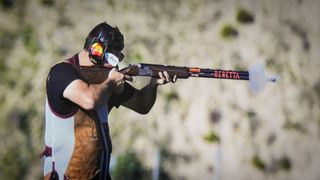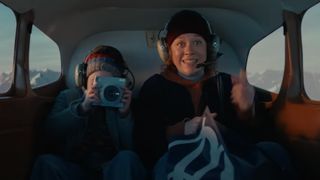First Person View, or FPV, simply means you can see as if you are inside the drone. In that respect, it's similar to the way the term is used in gaming. And, just as in gaming, some take the FPV concept a lot more literally. So much so, in fact, that FPV drone pilots are generally expected to be wearing video goggles. It is steeped in the history of the drone world. Even as a drone expert, it was a barrier I was nervous to cross – exciting and competitive – but I'm glad I gave it a go.
Many of the early drone enthusiasts built this way, placing a camera on the front of the ‘copter and piloting via a live view seen on video goggles. In fact cameras that record are still often just the best action cameras attached to the top. By piloting in this way, FPV fliers learn to master speed and dart through narrow gaps. FPV has always been popular with the hobby community, and even served as a spectator sport – everything from “Mini Air Shows” in 2015 to commercial TV events like Drone Racing League and Multi GP.
Because FPV pilots have also struck creative gold with one-shot flights which travel from the skies then through buildings, everyone wants in on FPV, and so it is no longer the preserve of self-building enthusiasts. Most drones have some form of screen relaying the live video, so a kind of first-person view. Some include the option to make the effect more 'real' by leaning the camera with the turns. And still others are designed especially for it.
We look at all the options and we look for speed, manoeuvrability, safety, latency (the responsiveness of the controls), and crash resistance (you will crash, but these drones should be built to handle it). Our best overall pick, the DJI Avata, handles all these in a balanced way, but the other options all have their merits...
Best FPV drones in 2023
Why you can trust Digital Camera World Our expert reviewers spend hours testing and comparing products and services so you can choose the best for you. Find out how we test.
Top Picks
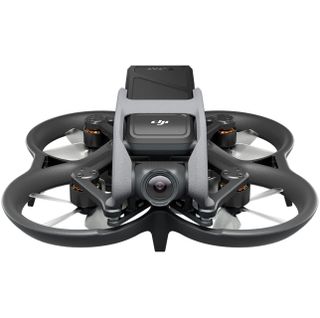
The Avata is the most well-rounded FPV drone out there; it can compete (and win) on video quality with top-notch stabilized 4K camera, ease of use, robustness, and pure joy thanks to DJI's unique floating joystick controller option.
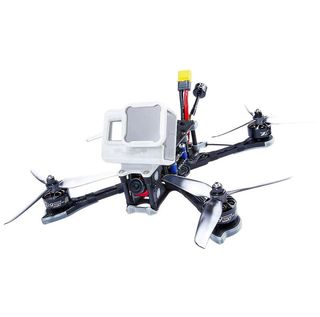
Freestyle flight is all about achieving acrobatic excellence and perfect flow, and the Nazgul has the right balance to handle tight corners while pulling off some tricks that'll impress – plus support for the latest video systems. Nice.

Arguably superseded by the Avata, the bigger, heavier, DJI FPV boasts collision sensors and the ability to go out shooting (and performing stunts) even against very strong breezes.
Best overall
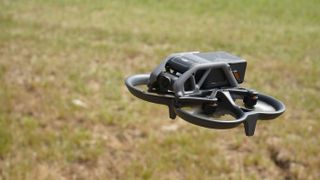
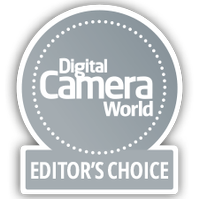
It’s easy to love the robustness (we checked!) DJI Avata, which makes the joys of FPV flight readily accessible for the average consumer. If this is your first FPV aircraft it’s a significant investment as you need all the accessories, and some space to fly.
What is exciting though is how easy things are beyond that, with consumer safety features and stability as well as a great camera; certainly better than most FPV drones with strapped-on GoPro Mini-like cameras that lack physical stabilization.
In other words, you can fly FPV – and capture amazing footage – without getting the soldering iron out. It’s also worth thinking that, in value terms, the GoPro which piggy-backs on a self-build is another cost, as is the controller, so the initial price isn’t so bad.
In terms of flaws, the ports are inconvenient. We’d also have liked one of DJI’s custom bags in the Fly More kit as it’s a clumsy collection of bits to carry.
The Avata isn’t quite for everyone because FPV will always be a little special. To unleash the maximum speed mode and acrobatics you’ll need to add a stick-type remote controller, which will add to the budget.
Still, the standard bundles are probably easier to use than the DJI FPV and, on balance, we’d take the whoop-style frame over the collision sensors any day.
Read our full DJI Avata review for more details
Best freestyle FPV drone


Powered by Xing-E 2207 2750KV motors, the Nazgul 5 might be named after the baddies in Lord of the Rings, but that power is a useful thing if you choose to act responsibly; many drone pilots lamented the increase in weight to the latest GoPro cameras, but this powerful machine seems unconcerned by the extra grams. (Perhaps that’s why it uses the Succex-EF4 flight stack?)
With 5mm thick carbon arms, this drone is going to be difficult to break even in a pretty fast collision, but if you want to try iFlight is offering the machine in both (fast) 4S and (screeching) 6S versions.
It can even keep up with a fixed wing. The firm is also well known for the quality of its default PIDs (flight settings), and this machine is no exception, which means even pilots used to the consumer-friendly experiences of camera drones should be able to transition to the world of FPV.
The drone includes the Caddx vista HD digital video transmission system, so you’ll likely need DJI FPV Goggles which will be something of an investment in themselves though. Other than that, you get a good selection of accessories in the box: antennas, tools, rubber battery stickers, props, and more.
Best FPV drone for cinematography


The DJI FPV is a drone with a lot of possible uses; it has a good quality camera that (if you supply fast enough MicroSD cards) can capture 4K at 60fps. Unusually for a dedicated FPV drone, the camera features mechanical stabilization (as does the Avata), albeit only on the X-axis (good digital image stabilization handles the Y-axis and camera vibration well).
Delicate gimbal motors might seem vulnerable, but the frame has a degree of roll-bar-like protection for the camera, and, perhaps more importantly, this is where DJI’s other major area of development plays a significant role: collision sensors – unlike the Avata which trusts the frame. They will either stop to hover or even steer around objects rather than hit them.
The real distinction though, and why it still makes our list under this heading is that the extra heft makes it such a good choice for filming in tricky conditions – for a practiced pilot at least. All DJI's camera drone tools are there, like the two lower (but still exciting) speed options. An ‘all stop’ button can also initiate hover nearly immediately, while the drone boasts the usual GPS-powered return-to-home expected on a consumer drone of this price.
DJI’s dedicated ‘FPV Goggles V2’ operate at 120fps and are also thoughtfully designed, with a large field of view not too taxing on the eyes or headband; the visual quality is breath-taking compared with early analog equivalents, but arguably the newer DJI Goggles 2 are more portable, bringing us back to the Avata (see our separate guide to the best FPV goggles).
Read our full DJI FPV Combo review for more details
Best all-in-one FPV kit
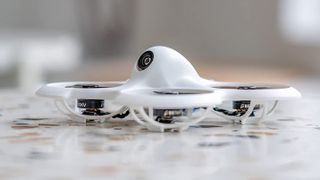
The Cetus is a small drone with the relatively unusual addition of an optical flow sensor. Not only does this offer drift-free hover, but a gentle automatic landing when the battery is failing – both huge boons for beginners.
First-time pilots can work their way up through three modes, including a full traditional FPV style. The same applies to the tech; the goggles and controller are of the same kind you can use with other real RF drones.
The controller, in fact, has an especially pleasing feel for ‘noobs’, with real RC-controller sticks surrounded by a more game-like housing. Indeed it can be used as a USB joystick when connected to drone simulators. It’s a shame that this is a live-view experience only – you’ll need to invest in pricier goggles for a record option – but this package is more about fun.
Best 2.5in FPV frame

Like it or not, the historical chain of names ending in “—whoop” is now part of quadcopter lore, and this is a Cinewhoop – meaning it has the power to lift a GoPro but isn’t too dangerous to avoid up close and personal. The word ‘pusher’ in the product name refers to the inverted engine arrangement, which makes it look a little like a skeletal hovercraft but has the effect of a cleaner airflow beneath the craft for smoother flight (and, by extension, smoother video).
The tiny size means it can be flown through small gaps, chasing subjects like skateboarders. It’s a few grams heavier than other 2.5-inch drones. We did wonder, however, if replacing the bull-nosed props with 5-blade types may offer a smoother flight, though any GoPro with image stabilization will see no issues anyway.
Flexibility is a big advantage of the FPV space, and the ProTek25 is available in analog too, but the digital option includes the Caddax Polar Vista 60fps FPV camera which will connect to the DJI goggles and controller.
Best for DJI O3 FPV
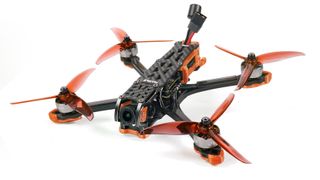
Freestyle airframes are built to take a lot of punishment with naked propellors for maximum efficiency. DJI’s latest transmission & control system for the FPV community, the O3, is a little bigger than its predecessor and can’t fit in many prior builds, which is why this airframe is such a good choice for someone going freestyle; it’ll let them use all the latest DJI gear (goggles, controller etc.) to maximum effect, while still mounting the FPV camera without problems. The kit also comes with all tools required to tweak your camera angle (many pilots like to experiment with this) and replace props.
Mostly, though, we love the power and flexibility; 4S and 6S versions lay down 1960KV and 2450KV through the SpeedX2 2107.5 brushless motors. And when you decide you want to check the engineering you can check the parameters live using Bluetooth and the SpeedyBee phone app – a much better solution than plugging into a computer.
Best tiny FPV drone
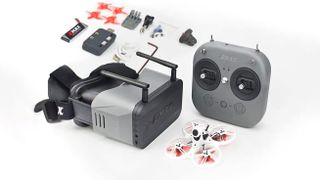
The EMAX TinyHawk 3 is a great nano drone to start flying with; the wheelbase (motor-to-motor measurement) is just 75mm, so the drone is smaller in the box than either the controller or goggles but, crucially, all those things are available in the same box, assuming you choose the Ready To Fly (RTF) bundle.
It’s possible to stay aloft for up to 7 minutes, OK for a machine with tiny 2-inch props, or blast along at up to 50mph (again impressive at this size). If you’re doing so in low light the array of LEDs provides the opportunity to wow the assembled crowds; their brightness responds to the accelerator.
In the past, Emax’s kits have included gamepad-like controllers, but this includes the new E8 transmitter which has a more traditional feel, better for learning pinch controls. It also has a mount for the bundled Transporter 2 receiver screen, which can either be worn as a traditional FPV screen or used atop the controller if preferred. The Transporter 2 can record video to an SD card, too.
While there isn’t the power to carry a GoPro, the camera provides surprisingly good-looking video – much more so than other small drones – thanks to its dynamic range, white balance, and the 200mw VTX (transmitter) which ensures better transmission than many in the category. The only real complaint is the ‘land now’ warning seems to come a little early, so the drone is better suited to racing flight than aggressive “acro” (acrobatics).
Best compact FPV for power

Bigger than some whoop-class drones, the CineLog 35 has a few refinements which make for longer flights. It’s also possible to sacrifice some minutes and direct the power to lift heavier GoPro cameras. You can hold a GoPro 10 aloft to record your flights for posterity using the included mount. Better still, the camera – if attached – will be connected to a dampening platform to reduce the jelly effect from the drone’s motors.
Nevertheless, the aircraft's 203 x 203mm pusher frame is 236.6g so you can also fly free of weight restriction concerns when you’re operating without a recording camera. GEPRC offers both a 4S and 6S edition of the compact quad.
Best for beginners
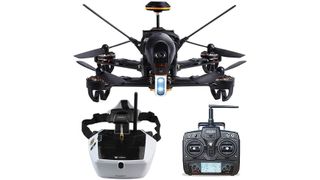
This deal isn’t the cheapest on here, and certainly not the newest, but the quad comes with everything you need to get flying except a 14.8 4S li-po and the balance charger you’ll need to top it up. That, though, is a choice most developing hobbyists want to make for themselves anyway, so there is no real loss there. The transmitter is powered by AA batteries which should last a while, and the F210 is largely built from carbon fiber so it’ll survive a few bumps – which is just as well.
We weren’t’ 100% sure about the two-blade props included; three-blade props can sometimes put out more power – but most of the time the difference wasn’t very apparent. Walkera used to make them available for an automatic 3D flight mode (the drone would automatically fly them backwards when the drone was inverted), but that novelty doesn’t seem to be on the list anymore and we can’t say we miss it, so why not tri-blade props? Ah well. On the plus side, having included goggles and a controller makes this a great starting FPV quad.
Best consumer drone with hint of FPV
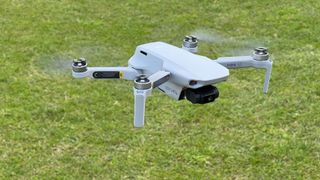
There is no arguing the quality and (crucially) relative value of the DJI Mini SE; it captures excellent video and images for a drone that's considerably cheaper than others in its stable. The only problem is that – by the strictest of enthusiast definitions – it isn’t technically an FPV drone.
That said, the view seen on your phone screen (acting as a monitor) is a first-person view. After all, a shooting game like Doom doesn’t require VR goggles. With a little ingenuity it is also possible to get that phone image in front of your eyes FPV-style: Get hold of a headset that can accept a mirrored video signal from your phone or an HDMI signal. If the latter, connect the HDMI to your phone using a device like a MiraScreen).
The fact the Mini SE isn’t the quickest drone is probably useful given that the digital video, especially mirror-cast (control isn’t as responsive as on a racer), but the experience is still good – plus all the advantages of DJI’s video recording system. In the Control menu, set the Gimbal Mode to FPV and the camera will tilt with the drone (rather than maintain level horizons), again like a ‘real’ FPV drone.
Read our full DJI Mini SE review for more details
FPV jargon made easy
Acro: acrobatics ARF: almost ready to fly (some construction needed)
BNF: bind and fly (a drone where you need to buy your own controller
Cinewhoop: Small drones designed for safe flying around people
FPV: first-person view Freestyle: Flying acrobatically / acro for fun
HUD: head-up display
Lipo: Lithium polymer battery
mAh: milli Amp hours (a measure of battery capacity)
PNP: plug and play (a drone where you need to provide the receiver/transmitter)
RTF: ready to fly Spotter: A friend to keep an eye on the wider airspace in case you get lost in the zone.
VTX: video transmitter
FPV systems explained
There are two kinds of FPV systems. Analog and digital. Both involve wearing goggles (We also have a guide to FPV goggles, by the way), but there are notable differences between the technologies.
Analog FPV: What are the advantages & disadvantages?
Analog was the first on the scene, and for a long time the only practical solution. The drone is fitted with a tiny analog camera and low-power NTSC or PAL transmitter (VTX). The pilot’s goggles including a receiver.
The technology is essentially the same as that once found in all TVs, except that you must choose the drone’s broadcast frequency, then make sure you match it on your goggles. The signal is visible to anyone who tunes in (but you won’t be transmitting far – authority rules keep power output to a minimum).
The radio control is 'bound' entirely separately to the drone’s ‘brain’ (flight controller), so does not occupy the same frequencies, but sometimes the transmitter overlays data onto the video feed, looking a bit like old-school VHS on-screen displays.
The tech is still relatively cheap, and the quality deteriorates in a natural way, rather than just dropping out, so you know it is time to turn around. The biggest plus is latency – there is essentially no delay in converting to digital and back, which makes stunt-flying super easy. The downside? Well, there was a reason HDTV came along and replaced this tech in the home! It's great to fly with, but you'll need to strap on a GoPro or equivalent to record good video.

Digital FPV: What are the advantages & disadvantages?
If you’re looking to add a high-quality digital video signal then you need a digital system. The compromises have, over generations, been largely ironed out, so latency (delay) is much less of an issue, though prices are still high.
DJI offer the DJI O3 Air Unit. This works with the newer FPV Goggles which arrived alongside the Avata. It offers a step up in reliability but, be warned, the 20mm lens won’t fit between the typical 19mm pillars on many freestyle frames. You might also try the Caddx Air Unit.
Digital systems ‘bind’ to each other with relative ease, and theoretically offer greater range without glitching video, but the downside is that when the glitches do come they can be more catastrophic than gradually degrading analog.
Do I need to buy an FPV drone to get FPV-style video?
No – most DJI drones have an "FPV mode" which can lean the camera with the drone's fuselage so you'll still get some of the stabilization effect but the video (and the live feed you watch as you shoot it) will have the impression of movement and speed that you get from FPV flying. For some, this will be the best of both worlds, and you'll find some good examples in our guide to the best camera drones and especially cheaper options in the best beginner drones.
How we test drones
Our drone tests are carried our in the field, allowing us to assess the quadcopter for its flight performance, easy of use, and its image quality. All our drone reviews are overseen by Adam Juniper who is one of the UK's leading experts in drone, and who has written several books on flying drones, including The Drone Pilot's Handbook.




